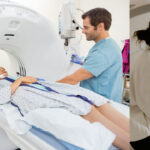Lung diseases are becoming increasingly common due to environmental pollution, smoking, infections, and lifestyle factors. When a doctor suspects a lung problem, one of the most reliable and detailed imaging tests they recommend is an HRCT Chest scan. HRCT, or High-Resolution Computed Tomography, provides crystal-clear images of your lungs, helping diagnose conditions that a regular X-ray might easily miss. If you’ve been advised to get an HRCT Chest, it’s normal to feel confused or worried. This guide explains everything in simple language so you know exactly what to expect.
What Is an HRCT Chest Scan?
An HRCT Chest scan is a specialized type of CT scan designed to capture high-resolution cross-sectional images of your lungs. Unlike standard CT scans, HRCT uses thin slices to show even the smallest details such as airways, lung tissue, and tiny structural changes. This helps doctors identify early-stage lung diseases that may not show up on X-rays. HRCT is widely used to diagnose interstitial lung diseases (ILDs), lung fibrosis, emphysema, bronchiectasis, and post-infection complications. It is one of the fastest and most accurate ways to assess lung health without any invasive procedure.
Why Doctors Recommend HRCT for Lung Problems
Doctors prefer HRCT because lung diseases are often subtle in the beginning. Early changes in the lungs—such as scarring, inflammation, or air trapping—are sometimes invisible on X-rays. HRCT gives a deeper look at the structure of your lungs, making diagnosis more precise. It also helps monitor how a disease is progressing or whether treatment is working. For example, after COVID-19, many patients developed long-term lung damage that was only visible on HRCT. For smokers, people with chronic cough, or those with unexplained shortness of breath, this scan provides much-needed clarity.
Conditions HRCT Chest Can Detect
HRCT is incredibly useful because it detects a wide range of lung conditions. It can identify diseases such as pulmonary fibrosis, COPD, bronchiectasis, hypersensitivity pneumonitis, interstitial lung diseases, and early signs of lung cancer. HRCT also helps assess lung infections, including tuberculosis and post-viral complications. If you have persistent cough, chest tightness, or difficulty breathing, this scan offers detailed insight into what could be wrong. Its ability to show fine structural details makes it essential for diagnosing conditions at an early, treatable phase.
When Should You Consider Getting an HRCT Chest?
Doctors recommend HRCT when symptoms such as ongoing cough, breathlessness, chest discomfort, or recurrent chest infections persist for weeks or months. You may also need it if you have a history of smoking, occupational exposure to dust or chemicals, or previously had COVID-19. HRCT is also used for follow-up in patients with diagnosed lung diseases to check for progression or improvement. Sometimes, HRCT is done even when symptoms are mild, especially if blood tests or X-rays show abnormal results. Early testing helps prevent complications and guides proper treatment.
How to Prepare for an HRCT Chest Scan
One of the best things about HRCT is that it requires very little preparation. You can eat and drink normally unless your doctor advises otherwise. Wear comfortable clothing and remove any metal objects before the scan. If contrast dye is required—which is not always necessary—inform the technologist about allergies or kidney problems. Try to stay calm and relaxed; the scan is quick, painless, and usually completed within minutes. Staying still during the scan is important because movement can blur the images.
What to Expect During the Procedure
When you arrive for your HRCT scan, you’ll be asked to lie on a moving table that slides into the CT scanner—a large, doughnut-shaped machine. The technologist will guide you throughout the process, often asking you to hold your breath for a few seconds to capture clear images. The machine does not touch you, and you won’t feel any pain. You may hear soft whirring sounds as the scanner rotates. Most scans take 5–10 minutes, and you can go home immediately afterward. HRCT is safe and noninvasive, with very minimal discomfort.
Understanding Your HRCT Chest Results
Your HRCT report provides detailed findings that help your doctor understand what is happening inside your lungs. The radiologist will describe patterns such as ground-glass opacities, fibrosis, nodules, or airway thickening. These patterns help identify specific diseases. For example, honeycombing suggests lung fibrosis, while mosaic attenuation may indicate air trapping. Although the report may look complex, your doctor will explain what the findings mean, how serious the condition is, and what the next steps should be. Accurate interpretation is crucial, so never self-diagnose based on a report alone.
Are There Any Risks Associated with HRCT?
HRCT is generally safe for most people. It uses a low dose of radiation, which is slightly higher than a normal CT scan but still within safe limits. It should be avoided during pregnancy unless absolutely necessary. If contrast dye is used, there is a small risk of allergic reactions, but these are rare and usually mild. Technologists are trained to ensure your safety throughout the scan. For most patients, the benefits of early and accurate detection far outweigh the minimal risks involved.
Treatment Path After an Abnormal HRCT Result
If your HRCT shows abnormalities, your doctor will plan treatment based on the diagnosis. This may include medications like steroids, inhalers, antibiotics, or antifibrotic drugs. Lifestyle changes such as quitting smoking, improving air quality, and regular exercise are often recommended. For chronic or progressive diseases, you might need pulmonary rehabilitation, oxygen therapy, or advanced treatments. Follow-up HRCT scans may also be required to monitor progress. Identifying lung problems early improves treatment success and helps prevent long-term complications.
Book Your HRCT Chest from Excel Lab Through InstaCare (Get 20% Off!)
If your doctor has advised an HRCT chest, booking it through InstaCare ensures convenience, affordability, and trusted quality. You can book your scan at Excel Lab, one of Pakistan’s top diagnostic centers, and get an exclusive 20% discount only when you book through InstaCare. The process is simple: select your test, choose your location, and confirm your appointment. Whether you prefer home sampling for related tests or a walk-in appointment, InstaCare makes the entire experience smooth. Early imaging leads to better diagnosis—so don’t delay your HRCT.
Conclusion
HRCT Chest is one of the most valuable tools for diagnosing lung diseases accurately and early. It helps doctors catch subtle changes in your lungs long before symptoms become severe. Whether you have persistent respiratory symptoms, a history of smoking, or simply want a thorough assessment, HRCT gives unmatched clarity. Remember, getting tested on time can make all the difference in managing lung conditions effectively. And with InstaCare’s exclusive discount at Excel Lab, prioritizing lung health has never been easier.
FAQs
- Is HRCT painful?
No, HRCT is completely painless and noninvasive. You simply lie still while the machine captures images of your lungs.
- How long does an HRCT Chest scan take?
The entire procedure usually takes 5–10 minutes, making it quick and convenient for patients.
- Can HRCT detect early-stage lung diseases?
Yes, HRCT is excellent for spotting early changes in lung tissues, even when symptoms are mild or absent.






